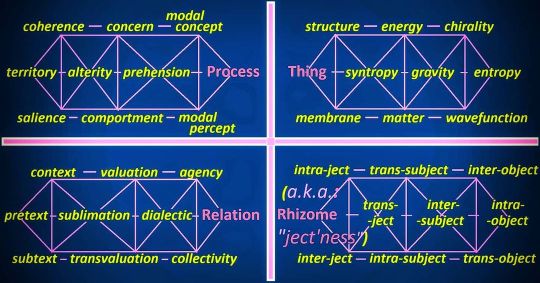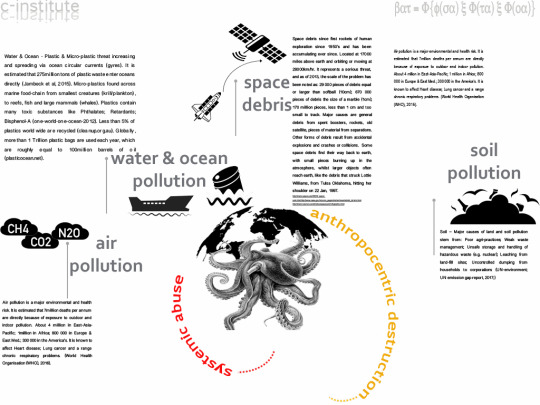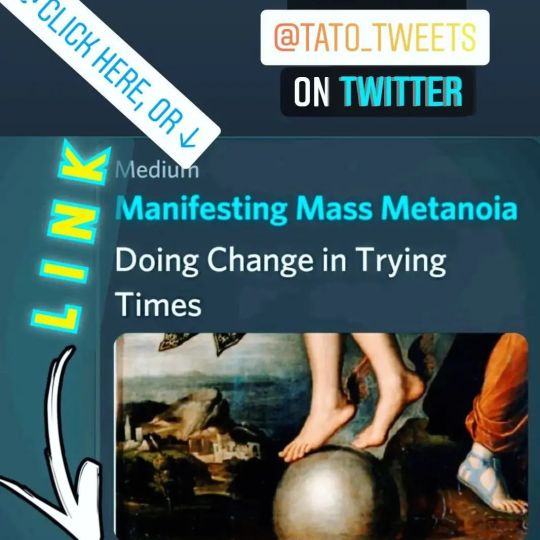#systemsscience
Explore tagged Tumblr posts
Photo

hey! Look here, i made a Kabbalah mandala of archetypes! . . . . . #DialecticalMaterialism, #rhizome #continentalphilosophy #tensegrity #IntegralTheory #phenomenology #SystemsScience #Tengri #Tengriism #Kabbalah #TranspersonalPsychology #Matrixial #psychoanalysis #SchizoAnalysis #Lacan #deleuzeguattari #Enneagram #NeuroDiversity #ObjectRelations #CosmologicalArgument #epistemology #ProcessRelational #Philosophy #emanationism #emergentism #metamodernism #mysticism #syntheism #archetypes #heterodox . https://www.instagram.com/p/CRcFA0CFwZT/?igshid=NGJjMDIxMWI=
#dialecticalmaterialism#rhizome#continentalphilosophy#tensegrity#integraltheory#phenomenology#systemsscience#tengri#tengriism#kabbalah#transpersonalpsychology#matrixial#psychoanalysis#schizoanalysis#lacan#deleuzeguattari#enneagram#neurodiversity#objectrelations#cosmologicalargument#epistemology#processrelational#philosophy#emanationism#emergentism#metamodernism#mysticism#syntheism#archetypes#heterodox
3 notes
·
View notes
Photo

#Takemeback to 2015: the #eGovernment Leadership Centre at the Institute of #SystemsScience, National University of #Singapore - #CIO Training Programme on Strategic Management of Information Technology. . . . . . . . . . . #Travel #Travelling #Traveling #TBT #Throwback #ThrowbackThursday #FBF #FlashbackFriday #Wanderlust #digitaltransformation #DigitalSkills #DigitalGovernment #AsianTiger #Training #Education #Scholarship #NeverStop #NeverStopLearning #Leadership #CIOLife #ChiefInformationOfficer #CSuite #CLevel (at Singapore e-Government Leadership Centre, NUS) https://www.instagram.com/p/CEaJDX-p5mu/?igshid=t5ge82lqvib7
#takemeback#egovernment#systemsscience#singapore#cio#travel#travelling#traveling#tbt#throwback#throwbackthursday#fbf#flashbackfriday#wanderlust#digitaltransformation#digitalskills#digitalgovernment#asiantiger#training#education#scholarship#neverstop#neverstoplearning#leadership#ciolife#chiefinformationofficer#csuite#clevel
0 notes
Text
Ecological entanglement (part 2 of 3)
Part of the slow uptake in systems sciences, have various underlying causes, chief of which is our “default-mechanistic thinking protocol”. In other words, being trained and schooled in mechanical linearity, we have produced neural pathways or search patterns that seeks out quick fixes and simplistic answers. A model and mindset that only works for simple problem types, not complex or wicked type problems that confront us today. This deeply ingrained, flawed response further support a major misconception that our problem solving skills have improved. This is clearly not the case if we look at global poverty, joblessness, inequality and the destruction of our oceans, soil, and air1. We have yet to admit that our developmental challenges are indeed wicked in nature. The fluidity of global socio-ecological problems reveals a gap between our environmental problems and our abilities to solve them5. Add, to this, our known limitations regarding wicked, messy, fluid type problems1, then the delusion is even clearer (e.g. mechanical leadership suggesting we grow ourselves out of poverty and inequality1, 10). The concept of constant or continuous growth defy our basic scientific laws (2nd law of thermodynamics), and as such, is a fairy-tale, to expect the global economy to “grow” itself out of poverty, inequality, and environmental ruin9, 1. Just consider that earth have finite renewable and non-renewable resources – a fact that remain absent from economic models? – reveals the scale of our dilemma. Economic activity is directly dependent upon earth’s ecosystems, underscoring the ignorance of searching for perpetual growth? Renewable resources have limited regenerative capacities (renewal abilities), a key underlying limitation making continuous growth impossible10, 11. Earth’s natural dynamics have intrinsic limits, like the maximum number of trees that can possibly grow, thus dictating maximum photosynthesis volumes. We are already using 25% of global photosynthesis8, which suggest a clear path toward self-induced extinction – literally growing ourselves to death. We must re-learn the vitality of Biophyllia and living within our natural boundaries10. Biophilia relates to our innate biological drive or desire to connect with nature14 since it is allied to human wellbeing and survival. Biophilia hypothesis explain the human need and desire to associate with biological or life processes14.
Since we are systemically linked to natural boundaries, much like predator-prey relations – i.e. the cyclic linkages between interdependent systems where over-feeding or exploitation by one, can lead to the extinction of both species. We must genuinely value systemic exploitation models and build the assurance that harvest rates will never equal regeneration rates; and also that our waste does not exceed the natural assimilation thresholds11. Such systemic integration holds multiple rewards like equality, and being sensitive to environmental limits12. Economics of Happiness12, is another systemic effort to undo the negative effects of globalisation, where conceptions of our apparent inferiorities serve selfish, gluttonous consumption motives. Constant messages to buy and consume now cover our entire life-spectrum, from cradle to grave - how we understand (education), to how we look (appearance), keenly turning us into mindless consumers1. This synthetic commercial culture is prolifically exported and deeply entrenched everywhere, the costs of which are known to damage the environment, whilst causing stress and illness in humans. To reverse these effects, researchers are investing in systemic-based solutions, like economic localisation, which bring economic activity closer to home, by supporting local communities versus distant and faceless corporations12. These efforts aim to change the structural flaws of industrialisation. It advances real, close contact between producers and consumers, which creates social cohesion and a sense of community, linking directly to happiness. Important, is the connection to nature, as a key factor influencing happiness. Research suggest “nature deficit disorder” (NDD), to describe humans deprived from contact with the living or biological world due to our constant technological exposure - computers, TV’s, smartphones, etc.
References:
Udemans, F., 2008, The golden thread: escaping socio-economic subjugation, an experiment in applied complexity science, Authorhouse UK;
2. Vanbergen, G., 2017, The crises of trust in Democracy & Globalisation, The European Financial Review, July 26, 2017, http://www.europeanfinancialreview.com/?p=1726; Smith, J.W., 1989, The World’s Wasted Wealth: the political economy of waste, New World’s Press, 1989, pp.44,45;
3. de Puydt, P.E., 1860, Panarchy (http://www.panarchy.org/depuydt/1860.eng.html), first published in French in the Revue Trimestrielle, Bruxelles, July 1860; Etymology of Panarchy, http://www.p2pfoundation.net/Panarchy_Etymology, from James P. Sewell and Mark B. Salter, "Panarchy and Other Norms for Global Governance: Boutros-Ghali, Rosenau, and Beyond", Global Governance, vol. 1, no. 3, pp. 373-382, 1995;
4. Folke, C., 2016, Framing Concepts in Environmental Science Online Publication Date: Sep 2016, 10.1093/acrefore/9780199389414.013.8, Oxford Research Encyclopedia of Environmental Science; (Folke, C., 2018, The Beijer Institute of Ecological Economics, Royal Swedish Academy of Sciences; Stockholm Resilience Centre, Stockholm University);
5. Berkes, F., Colding, J., Folke, C., 2003, Navigating social-ecological systems: Building resilience for complexity and change, Cambridge University Press, Cambridge, UK;
6. Holing, C.S., 2001, Understanding the complexity of economic, ecological and social systems, Ecosystems, Spinger-Verlag;
7. Biggs, R., Schlüter, M., Schoon, M.L., 2015. Principles for building resilience: sustaining ecosystem services in social-ecological systems. Cambridge University Press, Cambridge, UK. http://dx.doi.org/10.1017/cbo9781316014240
8. Vitousek, M.P., Ehrlich, R.P., Ehrlich, H.A., Matson, A.P., 1986, Human Appropriation of the Products of Photosynthesis, BioScience, Vol. 36, No. 6, June, 1986, page 368-373, University of California Press, American Institute of Biological Sciences Stable URL: http://www.jstor.org/stable/1310258;
9. Wahl, C.D., 2018, Building Capacity for the Re-design of our Economic Systems, Gaia Education, 16 March, 2018;
10. Daly. E.H., 2017, Sustainable Growth: An Impossibility Theorem, Gaian Economics: Living Well within Planetary Limits, Second volume, Gaia Education, Four Keys to Sustainable Communities series; https://medium.com/@gaiaeducation/sustainable-growth-an-impossibility-theorem-d78178dcac9c;
11. Brundtland et al, 1987, Brundtland Commission, https://en.wikipedia.org/w/index.php?title=BrundtlandCommission&oldid=847324915;
12. Norberg-Hodge. H, 2007, The Economics of Happiness, Gaian Economics: Living Well within Planetary Limits, Volume 2, Gaia Education’s Four Keys to Sustainable Communities series; The Economics of Happiness By Helena Norberg-Hodge Printed in Resurgence magazine 2007; http://www.skalaecovillage.com/wp-content/uploads/2015/10/Gaian_Economics.pdf#page=162; ��
13. Korten, D., 2006, The Great Turning: From Empire to Earth Community, Berrett-Koehler Publishers,2006; Gaian Economics, Volume 2, Gaia Education, Four Keys to Sustainable Communities series; Korten, D., 2006, The Great Turning: From Empire to Earth Community, Ready for a Change?, The Case for Earth Community, YES! A Journal of Positive Futures Summer 2006 17, 206/842-0216, www.yesmagazine.org;
14. Lumber R, Richardson M, Sheffield D, 2017, Beyond knowing nature: Contact, emotion, compassion, meaning, and beauty are pathways to nature connection, PLoS ONE 12(5): e0177186. https://doi.org/10.1371/journal.pone.0177186;

#globalwarming#globalisation#systemsscience#appliedcomplexityscience; ecosystem; systemscience#gigamaps#C-institute; The golden thread; Rich-poor; Socio-economic empowerment;
0 notes
Photo

https://medium.com/the-abs-tract-organization/manifesting-mass-metanoia-6f6362bb1a43 . , . #metamodernism, #metamodern #metamodernist #sensemaking #crises #SystemsScience #criticaltheory #manifesting #changemaker https://www.instagram.com/p/CamfO2lOwHk/?utm_medium=tumblr
#metamodernism#metamodern#metamodernist#sensemaking#crises#systemsscience#criticaltheory#manifesting#changemaker
2 notes
·
View notes
Photo

hey! Look here, i made a Kabbalah mandala of archetypes! . . . . . #DialecticalMaterialism, #rhizome #continentalphilosophy #tensegrity #IntegralTheory #phenomenology #SystemsScience #Tengri #Tengriism #Kabbalah #TranspersonalPsychology #Matrixial #psychoanalysis #SchizoAnalysis #Lacan #deleuzeguattari #Enneagram #NeuroDiversity #ObjectRelations #CosmologicalArgument #epistemology #ProcessRelational #Philosophy #emanationism #emergentism #metamodernism #mysticism #syntheism #archetypes #heterodox . https://www.instagram.com/p/CRcFA0CFwZT/?utm_medium=tumblr
#dialecticalmaterialism#rhizome#continentalphilosophy#tensegrity#integraltheory#phenomenology#systemsscience#tengri#tengriism#kabbalah#transpersonalpsychology#matrixial#psychoanalysis#schizoanalysis#lacan#deleuzeguattari#enneagram#neurodiversity#objectrelations#cosmologicalargument#epistemology#processrelational#philosophy#emanationism#emergentism#metamodernism#mysticism#syntheism#archetypes#heterodox
6 notes
·
View notes
Text
Cartographic clout (part 3 of 3)
Systemic type mapping can communicate complexities inherent in the system under study, which allow enrichment to stakeholder understanding (especially when dealing with diverse team members). As example, team members believing the project to be simple, will allocate far fewer resources, compared to team members who think it is a complex task. Merging or aligning these views are called sense sharing. Sense sharing hold practical consequences when looking at the different sensibilities we have regarding factors like bias, time, cost, quality, effort, and resistance to the projects we undertake. Our mechanistic legacy and our obsession with quick fixes for complex challenges create a lack of discipline to investigate and truly understand problem contexts. It is common today, for consultants and vendors to apply the same solution to a host of different contexts1, 3. This cut & paste mentality, is still common, and based upon mechanistic orientations, devoid of systemic viability like ecologically integrative considerations.
Considering that multi-disciplines or transdisciplinarity are inherent to complexity body of knowledge, the future need of these tools and insights will only grow1, requiring investment into these services and tools today, so that we can build these capacities. The systemic body of knowledge have influences from many disciplines like engineering, evolutionary biology, quantum mechanics, artificial intelligence, cybernetics, soft systems, hard systems, and more recently from architecture or design8. It adds to systemic knowledge by promoting design-centric visualisation in mapping processes and communications, like Giga-mapping - a broad map of multiple layers and scales8, useful on many levels. It also reveals inherent complexity and wickedness of real life problems8. It can be seen as an architectural variation of soft and hard system tools like: rich-pictures, concept maps, process maps, mind mapping, etc. Rich pictures are useful in building an overview, ordering and simplifying complex issues, whilst Giga-maps tend to be used to communicate design artefacts in itself8, helping to re-align and arrange complex information throughout the design process7. Systemic mapping tools help us all to understand system boundaries, which are vital in scientific theory and practice as it frame’s the system or intervention - notion of system-in-focus1. Because of systemic tools, we are better able to map, work with and engage in complex problems1, and considering that perfect information is a Newtonian flaw and mechanistic assumption that leads to divergent outcomes1. Systemic maps also tie into continuous learning1, whilst allowing expert knowledge to be accessed by laypersons as a form of self-development1, 8.
References
1. Udemans, F., 2008, The golden thread: escaping socio-economic subjugation: an experiment in applied complexity science, Authorhouse UK;
2. Barness, J., & Papaelias, A., 2015, Critical making: Design and the digital humanities, Visible Language 49.3, the journal of visual communication research, special issue, December 2015;
3. Schon, D., A., 1984, The reflective practitioner, New York, NY: Basic Books Inc.;
4. Jones, P., and Jeremy Bowes, J., 2017, Rendering Systems Visible for Design: Synthesis Maps as Constructivist Design Narratives, Journal of design economics and innovation, Tongji University and Tongji University Press,
Elsevier B.V., http://creativecommons.org/licenses/by-nc-nd/4.0/;
5. Kanarinka, 2006, Art-machines, Body-ovens, and map-recipes: Entries for a psychogeographic dictionary, Cartographic perspectives, Number 53, Winter, 2006;
6. Wikipedia, 2018, Mercator projection, https://en.wikipedia.org/w/index.php?title=Mercator_projection&oldid=862917060;
7. Firth, R., 2015, Critical Cartography, https://theoccupiedtimes.org/?p=13771, The Occupied Times of London (27), Retrieved 16 February 2018;
8. Sevaldson, B., 2011, Giga-mapping: Visualisation for Complexity and systems thinking in design, Conference Paper, June 2011, ResearchGate;

0 notes
Text
The thrust of trust (part 2 of 3)
Western nations have experienced massive losses in trust4, 6, with public confidence crashing to 13% of Greek, 30% of Spanish and 28% of French citizens having trust in their respective governments4. The OECD has called upon governments to win back citizen trust, which is essential if the State is to have people pay taxes, obey rules, comply to regulations and the law. The more people trust the State, the more they are likely to invest and spend in economic activity. Most importantly, trust is essential in times of sacrifice, like say austerity measures and ultimately, war.
High levels of trust are considered beneficial to society in general, which include a critical and questioning disposition forming a healthy layer of critique and protection. This mistrust is really a questioning temperament that motivates people to engage in politics5 - a counter-weight ensuring equality and fairness. Loss of trust stem from corrupt practices as it opposes the four aspects that underlie trust5: Corruption undermine efficiency and effectiveness of parliamentary rule; Corruption infers a lack of moral code without care for citizens; Corruption thrives off institutional limits; Corrupt societies are deemed unreliable (uncertainty in outcomes due to lack of assurance and standards)5. Corruption is thus the antithesis of trust – indeed research recognise a negative reinforcing cycle whereby corruption breeds distrust, which in turn feeds corruption5, 1.
As noted, the 2017 Trust barometer revealed the alarming level of distrust people have toward business, government, media, and NGO’s6. This should not come as a surprise since we have been highlighting the systemic subjugation of global citizens through these very structures. The trust barometer is simply another indication of citizens being and expressing their resentment toward institutional and structural corruption across key agencies as well as the leadership that occupy them. The need for empathetic and especially systemic orientation is well overdue as continued institutional failure can only result in collapse. Rebuilding trust is not an option, but a needed act in order to restore systemic confidence and faith. Agencies and institutions can only become relevant again, if they genuinely serve the people as a priority. Trust is vital for reasons like: Public policies that depend on behavioral compliance (e.g. paying tax); Investment; Consumer confidence; Economic and financial activities (e.g. banking services). Importantly, if people believe that elected officials are not playing by the same rules, they too will “game the system”, degenerating into an “every-man-for-himself” system. It is the negative feedback loop noted earlier when citizen’s view their government as corrupt they too, will start to cut corners. It would seem the crimes of those having power, have eventually resulted in a steady decline in global trust7. Citizens from various societies believe the overall system to be broken and unable to function effectively7, they mostly have contempt and require no further evidence of corrupt and inept leadership. The result is desperate reactions expressed in: extreme politics, like Brexit, the US election choices; institutional corruption with fake news and corporate deceptions. It reveals backward and selfish positions being adopted as last resort attempts to bolster trust7.
References:
Udemans, F., 2008, The golden thread: escaping socio-economic subjugation, an experiment in applied complexity science, Authorhouse UK;
2. Dalton, R.J., 2005, The social transformation of trust in government, International Review of Sociology, Volume 15, No. 1, March 2005, pp. 133 /154;
3. Mahmoud, Y., 2014, Pervasive disconnect between state and citizen offers two paths: Promise or Peril, International Peace Institute Global Observatory, June 16, 2014;
4. Alex Gray, A., 2017, A question of confidence: the countries with the most trusted government, World Economic Forum, Formative Content, 15 November 2017;
5. Van der Meer, T. and Dekker, P., 2011, Trustworthy states, trusting citizens? A multi-level study into objective and subjective determinants of political trust, In: Zmerli, S., & Marc, H., Political trust: Why context matters. Colchester: ECPR Press (995116);
6. Edelman Trust Barometer, 2017, http://edelman.com/research/edelman- trust-barometer-archive;
7. Vanbergen, G., 2017, The crises of trust in Democracy & Globalisation, The European Financial Review, July 26, 2017, http://www.europeanfinancialreview.com/?p=1726;
8. Vavreck., L., 2015, The Long Decline of Trust in Government, and Why that can be patriotic, NY Times, The Upshot, July 3, 2015, https://www.nytimes.com/2015/07/04/upshot/the-long-decline-of-trust-in-government-and-why-that-can-be-patriotic.html;
9. Stannard, M., 2016, From Wall street schemes to Debtor’s prisons: cities confront regressive debt collection, Public Banking Institute, March 26, 2016;
10. Smith, J.W., 1989, The World’s Wasted Wealth: the political economy of waste, New World’s Press, 1989, pp.44,45;

#fuadudemans; c-institute; thegoldenthread; universality; Economics; Socio-economics; Poverty&Wealth; self development; cyberiagroup;#design thinking#systemsscience#complexityscience
0 notes